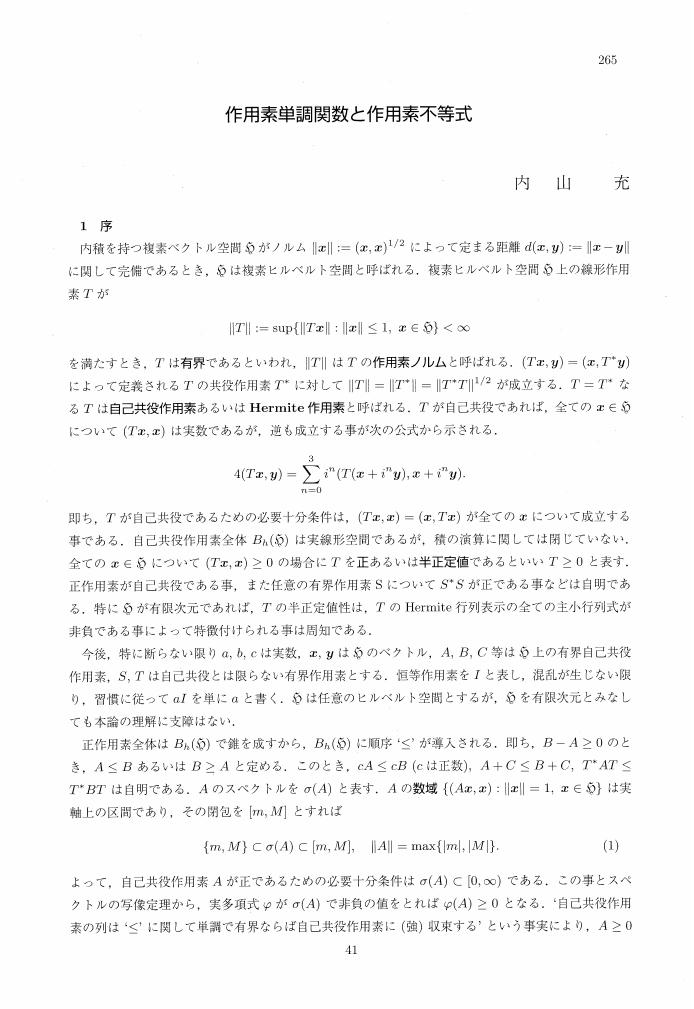- 著者
- 内山 充
- 出版者
- Japanese Society for Food Hygiene and Safety
- 雑誌
- 食品衛生学雑誌 (ISSN:00156426)
- 巻号頁・発行日
- vol.40, no.5, pp.335-355, 1999-10-05 (Released:2009-12-11)
- 参考文献数
- 20
- 被引用文献数
- 2 2
- 著者
- 関田 寛 武田 明治 内山 充
- 出版者
- Japanese Society for Food Hygiene and Safety
- 雑誌
- 食品衛生学雑誌 (ISSN:00156426)
- 巻号頁・発行日
- vol.24, no.1, pp.57-63, 1983
- 被引用文献数
- 1
多種多様の果実野菜類が世界中で大被害をこうむっているミバエ類に対して, 唯一有効なくん蒸剤であるとして植物検疫上世界各国で使用されているEDBには近年発癌性のあることが判明して以来, 食品衛生上重大な危ぐの念が抱かれるに至った. これを契機として, 著者らはEDBくん蒸後に輸入された生鮮果実類中のEDBの簡便迅速な残留分析法の確立を検討し, あわせて著者らの方法を用いて実態調査を行った.<br>1) EDBは果実類 (可食部) の均一化試料の水混和物から Dean-Stark 蒸留装置を用いて留出し, ヘキサン層に移行させ, ヘキサン層を液相分離用ロ紙を用いてろ過したものをECD付きガスクロマトグラフィーを行うことにより, 簡便かつ迅速に, しかも, 高感度かつ高精度に定性及び定量することができた. 本法におけるEDBの検出限界は0.005ppmであった.<br>2) 今回検討した果実類のうちで, グレープフルーツ以外の全ての果実試料検液のガスクロマトグラム上にそれらの果実成分に由来する大小多様のきょう雑ピークが観察された. これらのきょう雑ピークの除去法を検討したところ, 残留農薬分析に常用されている活性化フロリジルを検液中に直接添加することにより, レモン, オレンジ及びマンゴー試料の場合には, きょう雑ピークのみを完全に除去することができた. この方法により, レモン及びオレンジの場合には, ガスクロマトグラフイーの所要時間を大幅に短縮することができ, マンゴーの場合には, 保持時間が近接しているためにEDBとまぎらわしいきょう雑ピークを除去することができた. しかし, このフロリジル添加法は, パパイヤの成分に由来する検液注入約3時間後に出現する巨大なきょう雑ピークを消失させる効果は, 全く認められなかった.<br>3) 今回の調査結果では,1981年10月に米国から輸入されたレモンから0.045~0.617ppm, ネーブルオレンジから0.042~1.890ppm, 同時期にハワイ州から空輸されたパパイヤから0.084~0.465ppmのEDBが検出された. そしてこれらの一部のものには, 厚生省が定めたEDBの残留許容値 (0.13ppm) を越えるものがあった. 他方, 同時期にメキシコから輸入されたグレープフルーツからは0.040ppm以下の極めて低いEDB残留が認められたに過ぎなかった. また, 1982年3月フィリピンから空輸されたマンゴーからは, EDBは全く検出されなかった.<br>4) 生鮮果実類中に残留するEDBは, その初期濃度が同一でも, 果実の種類, 果実の保管貯蔵場所の室温あるいは通風換気の状況によって, その経時的減衰の動向が大きく異なることが推測された.
1 0 0 0 OA 第11改正日本薬局方について
- 著者
- 内山 充
- 出版者
- 公益社団法人 日本薬学会
- 雑誌
- ファルマシア (ISSN:00148601)
- 巻号頁・発行日
- vol.22, no.3, pp.271, 1986-03-01 (Released:2018-08-26)
1 0 0 0 OA 作用素単調関数と作用素不等式
- 著者
- 内山 充
- 出版者
- 一般社団法人 日本数学会
- 雑誌
- 数学 (ISSN:0039470X)
- 巻号頁・発行日
- vol.54, no.3, pp.265-279, 2002-07-30 (Released:2008-12-25)
- 参考文献数
- 51
1 0 0 0 OA 鯉による食中毒の原因究明に関する研究
- 著者
- 武田 由比子 天野 立爾 内山 充 松本 清司 降矢 強 戸部 満寿夫 本田 喜善 中村 幸男
- 出版者
- Japanese Society for Food Hygiene and Safety
- 雑誌
- 食品衛生学雑誌 (ISSN:00156426)
- 巻号頁・発行日
- vol.21, no.1, pp.50-57_1, 1980-02-20 (Released:2009-12-11)
- 参考文献数
- 5
- 被引用文献数
- 2 2
1976年から1978年まで宮崎, 佐賀, 鹿児島において17件の鯉摂取によるとみられる食中毒が発生し患者125名に達した. 中毒症状は嘔吐, 痙れん, 麻痺などで, 疫学調査により共通食品に鯉があげられ, 食べ残りの鯉をイヌに与えたところ, 人の場合と同様に発症した. この有毒鯉からの熱エタノール抽出物をエーテルに転溶しTLCを行った結果Rf値0.5~0.7 (展開溶媒ベンゼン, アセトン, 酢酸, 90+5+5)で硫酸噴霧後加熱により特異な青緑色を呈するスポットに毒性を認めた. この物質をさらに精製しUVλEtOHmax 220, 282nm, MSより分子量575を得たが化学構造などについてはなお検討中である.
- 著者
- 豊岡 利正 山崎 壮 谷本 剛 佐藤 恭子 佐藤 道夫 豊田 正武 石橋 無味雄 義平 邦利 内山 充
- 出版者
- The Pharmaceutical Society of Japan
- 雑誌
- Chemical and Pharmaceutical Bulletin (ISSN:00092363)
- 巻号頁・発行日
- vol.39, no.3, pp.820-822, 1991-03-25 (Released:2008-03-31)
- 参考文献数
- 9
- 被引用文献数
- 27 42
To identify chemical contaminant(s) associated with eosinophilia-myalgia syndrome (EMS), case and control lots of tryptophan were analyzed by HPLC with both UV and FL detection. Numerous contaminant peaks appeared on the chromatograms and some of them were identified as 5-hydroxytryptophan, indol aldehyde, indol, etc. from the retention time of authentic compounds. Among these, three peaks were significantly associated with case lots. One corresponds to di-tryptophan aminal of aldehyde (peak E). Ohters are unknown contaminants, UV-5 (FL-7) and UV-28 (FL-36). The structural elucidation and toxicological implication of UV-5 (FL-7) are currently in progress.
- 著者
- 中川 満夫 村田 剛 下川 晃彦 本田 俊哉 児島 昭次 内山 充
- 出版者
- 公益社団法人日本薬学会
- 雑誌
- 衛生化学 (ISSN:0013273X)
- 巻号頁・発行日
- vol.30, no.5, pp.301-308, 1984-10-31
The methods for analyzing residual methylene blue and malachite green in the muscle and liver of rainbow trout and eel were established. Since methylene blue and malachite green in the muscle and liver homogenates were effectively extracted by n-butanol in the presence of ZnSO_4,the recoveries of methylene blue and malachite green were determined by measuring the optical density (665 nm for methylene blue, 620 nm for malachite green) of butanol solution extracted from the liver and muscle homogenates containing the dyes. However, the optical density of malachite green in butanol solution extracted from the liver homogenates was measured at 500 nm, 620 nm and 700 nm, and was then calculated from the following equation ; Net OD_<620>=(MOD_<620>-OD_<700>)-[(OD_<500>-OD_<700>)×0.4815-0.0033] MOD_<620> : OD observed at 620 nm : malachite green + pigments of liver homogenates The recoveries of methylene blue and malachite green added to the muscle homogenates were 80-87% and 80-88%, respectively. The limits of detection in the muscle were 0.1 μg/g for both dyes. Also, the recoveries of methylene blue and malachite green added to the liver homogenates were approximately 85-87% and 88-95%, respectively. As little as 0.5 μg/g of both dyes in the liver was detectable. On the other hand, when rainbow trout were exposed to 0.5,1.0 and 2.0 ppm of malachite green solution at 16℃ for 1 h, residual amounts of malachite green in the muscle and liver were 1.41±0.28 μg/g (muscle) and 5.9±1.2 g/g (liver), 2.41±0.11 μg/g (muscle) and 10.1±1.4 μg/g (liver), and 5.90±1.61 μg/g (muscle) and 19.1±2.8 μg/g (liver), respectively. Also, when eel were exposed to 3.0 ppm of methylene blue solution at 16℃ for 1,2 and 3 h, residual amounts of methylene blue in the liver was 1.20±0.3 μg/h, 1.10±0.5 μg/2 h and 0.90±0.2 μg/3 h, respectively, and residual methylene blue in the muscle could not be detected.
1 0 0 0 OA Tocopheronolactoneの生理活性について(第1報)
- 著者
- 内山 充 鈴木 康男 福沢 健治
- 出版者
- 公益社団法人日本薬学会
- 雑誌
- 藥學雜誌 (ISSN:00316903)
- 巻号頁・発行日
- vol.88, no.6, pp.678-683, 1968-06-25
- 被引用文献数
- 33
Mechanism of antioxidation of tocopheronolactone, isolated as the quinonoid metabolic product of α-tocopherol, was examined. Tocopheronolactone was as effective as α-tocopherol in inhibiting the increase of TBA value during the in vitro incubation of α-tocopherol-deficient mouse liver homogenate, but the production of peroxide from unsaturated fatty acids irradiated with ultraviolet ray was not depressed by the sole addition of tocopheronolactone. Reduced tocopheronolactone depressed TBA value during the irradiation of unsaturated fatty acid with ultraviolet ray and reacted with the stable free radical α, α-diphenyl-β-picrylhydrazyl, but tocopheronolactone was not active. Reduced tocopheronolactone was oxidized to tocopheronolactone by free radical products of heme-catalyzed decomposition of cumene hydroperoxide. Tocopheronloactone in cytoplasm was reduced in 9000×g supernatant fraction but not in mitochondria, so that mitochondrial peroxidation was not inhibited by tocopheronolactone itself. Antioxidativeeffect of tocopheronolactone seems to appear after the biochemical reduction of the tocopheronolactone in vivo, followed by the reaction with free radicals and peroxides.



